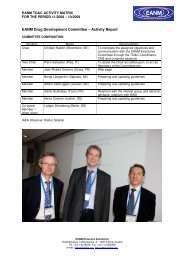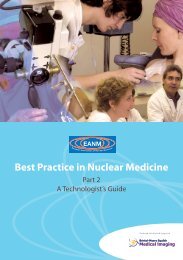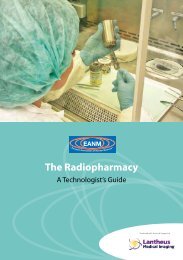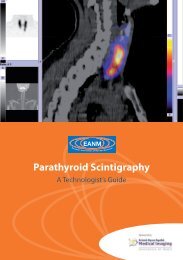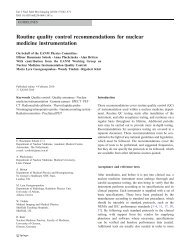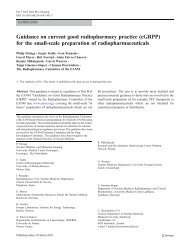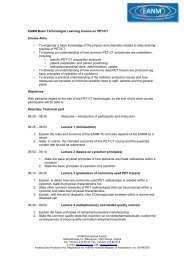Radiopharmacy quality control - European Association of Nuclear ...
Radiopharmacy quality control - European Association of Nuclear ...
Radiopharmacy quality control - European Association of Nuclear ...
Create successful ePaper yourself
Turn your PDF publications into a flip-book with our unique Google optimized e-Paper software.
<strong>Radiopharmacy</strong> <strong>quality</strong> <strong>control</strong><br />
P. Maltby, Liverpool (UK)<br />
1. INTRODUCTION<br />
The overwhelming majority <strong>of</strong> radiopharmaceuticals used for diagnosis and therapy in <strong>Nuclear</strong><br />
Medicine are administered to patients as intravenous injections. The <strong>European</strong> Pharmacopoeia<br />
mandates that all injections must be sterile, apyrogenic, free from extraneous particles and be <strong>of</strong> a<br />
suitable pH. In addition, radioactive injections must be <strong>of</strong> the correct radiochemical and radionuclidic<br />
purity and have the correct radioactivity present at the stated time <strong>of</strong> injection.<br />
The EC Guide to Good Manufacturing Practice Vol. IV [1]lays down the requirements for the minimum<br />
standards for facilities personnel and <strong>quality</strong> systems that must be in place for commercial<br />
manufacturers to be able to market such products, and similarly the PIC/S have defined standards for<br />
hospital preparation <strong>of</strong> radiopharmaceuticals []. In the UK, guidance for <strong>quality</strong> assurance <strong>of</strong><br />
radiopharmaceuticals has also been issued [3].<br />
Quality <strong>control</strong> <strong>of</strong> radiopharmaceuticals is therefore necessary for 2 distinctly separate but linked<br />
reasons as they relate to pharmaceutical parameters and radioactive parameters.<br />
1. Pharmaceutical parameters designed to ensure that no microbiological, pyrogenic or particulate<br />
contamination can harm patients.<br />
2. Radioactive parameter designed to ensure that that the intended radiation exposure <strong>of</strong> patients is<br />
kept to a minimum by confirming that the radioactivity, radiochemical and radionuclidic purity are<br />
assured. These additional factors have an effect on the overall radiation dose to the patient, as<br />
impurities <strong>of</strong> the radionuclide and/or its chemical composition may affect the biodistribution <strong>of</strong> the<br />
injected radiopharmaceutical and consequently the radiation dose to any one particular organ or<br />
the whole body dose (ED – Effective Dose).<br />
2. METHODS FOR ASSESSING RADIOACTIVE PARAMETERS<br />
2.1 Activity check<br />
There are very strict limits on the amount <strong>of</strong> radioactivity that can be administered for each type <strong>of</strong><br />
investigation to be performed. These limits are set by the legislative bodies in individual countries.<br />
Therefore, all radioactive preparations must be checked for activity before administration [3]. Most<br />
radionuclide calibrators used in radiopharmacy are ionisation chambers. Commercial calibrators have<br />
built in scaling factors for individual radionuclides that take into account the ionising ability <strong>of</strong> the<br />
isotope and give a read out in the appropriate units (kBq or MBq, or mCi). However, this type <strong>of</strong><br />
calibrator is not ideal for all radionuclides. Low energy radiation, such as that produced by Iodine [ 125 I],<br />
may be attenuated before reaching the gas and the measurement may be inaccurate. Also, high<br />
energy beta particles interact with the chamber wall and the measurement <strong>of</strong> activity is based on the<br />
Bremsstrahlung radiation produced. The activities dispensed in a radiopharmacy need to be measured<br />
to a precision <strong>of</strong> 2-5%. It is very important that the radionuclide calibrator used is working correctly and<br />
a strict QA regime should be followed to ensure this. Daily, the calibrator is checked for accuracy<br />
against a long-lived reference sealed source (e.g. Cobalt [ 57 Co] or Americium [ 241 Am]), there should<br />
also be an annual linearity check. The accurate determination <strong>of</strong> low activities <strong>of</strong> X-ray and gammaemitting<br />
radionuclides can be carried out using a well scintillation counter, in which a scintillant crystal<br />
produces a flash <strong>of</strong> light when struck by an ionising particle or photon. The light produced is converted<br />
to an electrical signal by a photomultiplier, this can then be amplified and counted. Gamma and X-rays<br />
are best detected with crystals <strong>of</strong> Thallium-activated Sodium Iodide (NaI(Tl)). In a well counter the<br />
source is placed inside a well drilled in the centre <strong>of</strong> a cylindrical crystal. Liquid scintillation counting is<br />
used in the measurement <strong>of</strong> beta emitters, such as Hydrogen [ 3 H] and Carbon [ 14 C].<br />
2.2 Radionuclide identity<br />
A radionuclide can be identified by measuring the half-life <strong>of</strong> the radionuclide and/or determining the<br />
energies <strong>of</strong> the emitted radiation.<br />
a) The half-life is measured with a suitable detector (see above). There must be sufficient activity in<br />
the sample so that it can be measured for several half-lives, but limited to minimise count rate<br />
defects and effects such as dead time losses. Multiple measurements are made in the same<br />
geometrical conditions, for a time at least equal to three expected half-lives. A graph is drawn with<br />
the logarithm <strong>of</strong> the instrument response against time. The half-life is calculated from the graph
and should not differ by more than 5% from the half-life stated in the Pharmacopoeiae.<br />
b) The nature and energy <strong>of</strong> the radiation emitted may be determined by several procedures<br />
depending on the type <strong>of</strong> radiation emitted. Radionuclides which emit gamma rays or detectable<br />
X-rays can be analysed using gamma spectrometry. The spectrum can be used to identify which<br />
nuclides are present in a source and in what quantities.<br />
2.3 Radionuclidic purity<br />
This is the amount <strong>of</strong> radioactivity due to the radionuclide concerned compared to the measured<br />
activity <strong>of</strong> the radiopharmaceutical preparation. It is usually expressed as a percentage. The relevant<br />
monographs in the Pharmacopoeiae give limits to the radionuclidic impurities allowed in each<br />
preparation. If significant levels <strong>of</strong> other radionuclides are present then biological distribution may be<br />
altered. Radionuclide impurities can occur as a result <strong>of</strong> the manufacturing process, for example, for<br />
nuclides produced by cyclotron there can be contaminants due to impurities in the target or by the<br />
energy <strong>of</strong> the reaction. For example Yttrium [ 86 Y], for use in PET, is produced by the reaction (p,n) on<br />
a target <strong>of</strong> Strontium [ 86 Sr] using protons with energy <strong>of</strong> 16 MeV. If an energy <strong>of</strong> 30 MeV is used then<br />
Yttrium [ 85 Y] is also produced which decays to Strontium [ 85 Sr]. This radionuclide has a long half-life<br />
and targets bone, having serious implications for patients. Impurities can also arise due to the<br />
presence <strong>of</strong> the parent nuclide <strong>of</strong> the stated nuclide when the stated nuclide is obtained by a<br />
separation technique such as a generator elution, for example, the presence <strong>of</strong> Molybdenum [ 99 Mo] in<br />
a solution <strong>of</strong> Technetium [ 99 Tc m ]. The presence <strong>of</strong> Molybdenum [ 99 Mo] in a Technetium [ 99 Tc m ]<br />
radiopharmaceutical would be detrimental for patients due to the beta emission <strong>of</strong> this radionuclide<br />
and the long half-life (66 hours) giving an increased radiation dose.<br />
The radionuclidic purity can be determined by gamma spectrometry or by the determination <strong>of</strong> the<br />
half-life. The half-life method is useful for very short-lived isotopes for use in PET, such as Oxygen<br />
[ 15 O] (half-life 2 min).<br />
A version <strong>of</strong> the attenuation method can be used to determine the amount <strong>of</strong> Molybdenum [ 99 Mo] in a<br />
solution <strong>of</strong> Technetium [ 99 Tc m ] as these two radionuclides emit gamma radiation <strong>of</strong> very different<br />
energies. The activity <strong>of</strong> the sample is determined in an ionisation chamber on the technetium setting.<br />
The activity measured will be due to the Technetium [ 99 Tc m ] and the Molybdenum [ 99 Mo]. The sample<br />
is then placed in a lead canister with wall thickness <strong>of</strong> 6 mm and measured again on the molybdenum<br />
setting. The radiation emitted by the Technetium [ 99 Tc m ] has an energy <strong>of</strong> 140 keV which is absorbed<br />
by the lead. The radiation emitted by the Molybdenum [ 99 Mo] has an energy <strong>of</strong> 740 keV and is only<br />
attenuated by a third. Any measured activity is therefore due to the Molybdenum [ 99 Mo] present. The<br />
proportion <strong>of</strong> molybdenum in the sample can then be calculated. The limit allowed is 0.1%<br />
contaminating Molybdenum [ 99 Mo]. This test should be performed daily on the first elution from a<br />
generator.<br />
Due to differences in the half-lives <strong>of</strong> the different radionuclides that can be present in a preparation,<br />
the radionuclidic purity changes with time. The requirement <strong>of</strong> the radionuclidic purity must be fulfilled<br />
throughout the period <strong>of</strong> validity.<br />
2.4 Radiochemical purity<br />
It is important to know that the majority <strong>of</strong> the radioactive isotope is attached to the ligand and is not<br />
free or attached to another chemical entity as these forms may have a different biodistribution. This is<br />
termed the radiochemical purity. In diagnostic scanning the different biodistribution <strong>of</strong> contaminating<br />
radioactive chemicals could interfere with the clinical diagnosis by obscuring the region <strong>of</strong> interest and<br />
interfering with the interpretation <strong>of</strong> the scan. This could result in the patient returning to the<br />
department for a repeat scan with all the cost implications for the department and a repeat radiation<br />
dose for the patient, or, more seriously, to a misinterpretation <strong>of</strong> the images. Abnormal biodistribution<br />
can also be due to other causes such as patient medication, therefore determining the RCP could help<br />
to clarify an abnormal scan by ruling out defective product. In radiopharmaceuticals used for therapy a<br />
low RCP could mean an unacceptable radiation dose to healthy organs and tissues.<br />
For most radiopharmaceuticals the lower limit <strong>of</strong> RCP is 95%, that is, at least 95% <strong>of</strong> the radioactive<br />
isotope must be attached to the ligand. RCP determination can be carried out by a variety <strong>of</strong><br />
chromatographic methods:<br />
2.4.1 Paper and thin layer chromatography<br />
In these methods a small drop <strong>of</strong> the radiopharmaceutical is put onto the bottom <strong>of</strong> a strip <strong>of</strong> support<br />
medium (e.g. paper, silica gel coated sheets). The strip is put into a tank containing a small amount <strong>of</strong><br />
solvent. The solvent migrates up the strip. The components <strong>of</strong> the radiopharmaceutical are separated
according to the solubility in the solvent and adsorption to the support medium. Detection <strong>of</strong> the<br />
radioactivity in the strip can be carried out in a number <strong>of</strong> ways.<br />
a) The simplest method is to cut the strip and count the activity in the sections in a radionuclide<br />
calibrator or a well scintillation counter. The percentage <strong>of</strong> activity in each section can then be<br />
determined. For example, if a strip is cut in two sections ‘A’ and ‘B’ then the percentage activity in<br />
section A is given by:<br />
%A = A x 100<br />
A+B<br />
This method does have several limitations however. Radionuclide calibrators are inaccurate for<br />
samples <strong>of</strong> low activity due to the lower level <strong>of</strong> detectability and the accuracy <strong>of</strong> the calibrator at<br />
the lower range setting, and well scintillation counters should be avoided for samples <strong>of</strong> high<br />
activity, as these can exceed the count rate capabilities due to the resolving time <strong>of</strong> the detection<br />
system.<br />
b) The strip can be imaged under a gamma camera. Regions <strong>of</strong> interest can be drawn around the<br />
areas <strong>of</strong> radioactivity and the percentage <strong>of</strong> counts in each region can be determined. This method<br />
has the advantage <strong>of</strong> imaging the whole chromatography strip enabling artefacts to be seen,<br />
however, it is not practicable for most hospital departments due to the cost <strong>of</strong> camera time.<br />
c) The strip can be imaged using a radiochromatogram scanner. A radiochromatogram scanner uses<br />
a sodium iodide detector to detect the radioactive emission. If the scanner is linked to an integrator<br />
then quantification <strong>of</strong> the peaks can be carried out. This equipment is not suitable for counting<br />
emissions from some isotopes (for example Chromium [ 51 Cr] or Iodine [ 125 I]) due to statistics<br />
associated with counting low activities.<br />
d) Analysis <strong>of</strong> the strip can be performed using storage phosphor imaging. A phosphor screen<br />
accumulates a latent image <strong>of</strong> the distribution <strong>of</strong> radioactivity on the strip. Scanning the screen<br />
with a laser allows the location and intensity <strong>of</strong> radioactivity to be analysed and stored for future<br />
reference. Results are shown as an image <strong>of</strong> the strip. Regions <strong>of</strong> interest can be drawn and<br />
integration carried out to determine activity in each region.By varying the time <strong>of</strong> exposure <strong>of</strong> the<br />
strip to the phosphor screen, radiopharmaceuticals containing many different isotopes, or <strong>of</strong><br />
different activities, can be analysed.<br />
One <strong>of</strong> the biggest drawbacks to paper and thin layer chromatography methods <strong>of</strong> determining RCP is<br />
the resolving power <strong>of</strong> the methods. Most methods commonly used will only resolve one component<br />
and so two or three methods may be needed to identify all the major contaminants in a product. Time<br />
can also be a limiting factor with some methods taking 20-30 minutes to develop, or even longer.<br />
2.4.2 Solid Phase Extraction (SPE)<br />
A variety <strong>of</strong> bonded silica sorbents are available packed into disposable cartridges or columns. The<br />
sorbent will selectively retain specific types <strong>of</strong> chemical compounds from the sample loaded on the<br />
column. There are many different sorbents available and many suppliers and manufacturers <strong>of</strong> SPE<br />
columns and cartridges. Components can be selectively eluted by careful choice <strong>of</strong> solvents. Eluates<br />
are collected and have sufficient activity that they can be counted in a radionuclide calibrator. The<br />
procedure takes about 5 min ensuring that RCP determination can be carried out before<br />
administration <strong>of</strong> the patient dose.<br />
2.4.3 High Performance Liquid Chromatography (HPLC)<br />
TLC RCP methods may not be sufficient to identify all the compounds which are present in a product.<br />
HPLC has a higher sensitivity and resolving power than simple TLC methods. HPLC separation<br />
operates on the hydrophilic/lipophilic properties <strong>of</strong> the components <strong>of</strong> a sample applied. Gamma<br />
emmitters are detected using a well scintillation counter connected to a rate meter. Other detectors<br />
(UV or refractive index) can be connected in series allowing simultaneous identification <strong>of</strong> compounds.<br />
It should not be necessary to perform HPLC on radiopharmaceuticals reconstituted from licensed cold<br />
kits. It is useful to have techniques available for the purpose <strong>of</strong> eliminating a cause <strong>of</strong> any abnormal<br />
patient scan. For radiopharmaceuticals prepared ‘in-house’ or novel compounds for research<br />
purposes, an HPLC method for estimating radiochemical purity is essential. It should be noted that<br />
HPLC does not detect colloidal contaminants and that this should be estimated using TLC methods.<br />
2.4.4 Electrophoresis<br />
Electrophoresis separates components in a sample according to the charge and size <strong>of</strong> the molecules.<br />
The most frequently used electrophoresis method in radiopharmacy is in the RCP determination <strong>of</strong><br />
radiolabelled albumin where the sample is run on a support <strong>of</strong> filter paper in a barbitone buffer.
2.5 Chemical purity<br />
Chemical purity requires the identification and quantification <strong>of</strong> individual chemical constituents or<br />
impurities in a radiopharmaceutical preparation. A routine test for chemical purity is performed on the<br />
Technetium [ 99 Tc m ] Sodium Pertechnetate solution eluted from a generator. Technetium [ 99 Tc m ]<br />
Sodium Pertechnetate solution may be contaminated with aluminium, which originates from the<br />
alumina bed <strong>of</strong> the generator column. The presence <strong>of</strong> aluminium can interfere with the preparation <strong>of</strong><br />
some Technetium [ 99 Tc m ] -colloidal preparations and also with the labelling <strong>of</strong> red blood cells with<br />
Technetium [ 99 Tc m ] , causing their agglutination. The aluminium in the eluate can be detected using a<br />
simple paper test which is commercially available. Filter paper is impregnated with a colour<br />
complexing agent. A standard solution <strong>of</strong> aluminium (10mgml -1 ) is supplied. A spot <strong>of</strong> the standard<br />
solution causes a colour change in the paper. A spot <strong>of</strong> generator eluate is compared to the standard<br />
spot. If the colour is more intense in the eluate spot then the eluate contains more than 10 mgml -1<br />
aluminium and implies a lack <strong>of</strong> stability in the column, consequently the eluate should be discarded.<br />
It should not be necessary to perform other chemical tests on licensed radiopharmaceuticals.<br />
Unlicensed radiopharmaceuticals should be checked for chemical purity to ensure the <strong>quality</strong> <strong>of</strong> the<br />
product. This would include the quantification <strong>of</strong> the normal constituents <strong>of</strong> a labelling kit i.e. the ligand<br />
and reductant. Synthesis precursors or catalysts used in the preparation should be tested for.<br />
Commonly, this can be carried out using HPLC. Gas chromatography methods are used to test PET<br />
tracers for residual solvents used in the synthesis <strong>of</strong> these agents.<br />
3. METHODS FOR ASSESSING PHARMACEUTICAL PARAMETERS<br />
3.1 pH<br />
The pH <strong>of</strong> the preparation should be in the physiologically acceptable range (5.5 - 8) or at the optimum<br />
pH for the stability <strong>of</strong> the preparation. It is especially important to check the pH <strong>of</strong> PET<br />
radiopharmaceuticals as preparative operating procedures may include extreme pH conditions which<br />
need neutralization. pH can be checked by placing a drop <strong>of</strong> solution on pH paper. Reading the paper<br />
is done by referring to a colorimetric pH scale. Micro pH meters are available which can read a drop <strong>of</strong><br />
liquid (10 ul) placed on the electrodes.<br />
3.2 Apyrogenicity<br />
Bacterial endotoxins (pyrogens) are polysaccharides from bacterial membranes. They are water<br />
soluble, heat stable, and filterable. If they are present in a preparation and administered to a patient<br />
they can cause fever and also leukopenia in immunosuppressed patients. To minimise the chances<br />
that pyrogens are present it is important that preparations are manufactured and dispensed under<br />
aseptic conditions and that all consumables and equipment used have been heat treated and known<br />
to be pyrogen free. Most licensed products are guaranteed pyrogen free. PET products, whether<br />
manufactured commercially or in Hospitals, must be tested for pyrogens prior to or immediately<br />
following use. The most popular method is the limulus amoebocyte lysate test. However data exists<br />
confirming that some radiopharmaceuticals may directly cause precipitation or interfere with the<br />
forming gel.<br />
3.3 Visual examination<br />
As with all pharmaceutical preparations, radiopharmaceuticals should undergo a visual examination.<br />
The examination should should take into account radiation protection issues for the operator and be<br />
conducted as quickly as possible with the preparation behind suitable shielding. Vials should be<br />
examined for insecure closures, cracks, glass particles in the liquid, and particulate contamination.<br />
Syringes should also be examined for particulate contamination.<br />
3.4 Sterility<br />
In the UK it is recommended that retrospective sterility testing <strong>of</strong> products is undertaken three times a<br />
week. A sample (0.3-0.5ml) <strong>of</strong> the first elution (used) <strong>of</strong> each new generator is aseptically transferred<br />
to two different sterile culture media contained in 100ml rubber stoppered vials. These are then<br />
incubated within the <strong>Radiopharmacy</strong> department at the correct temperature for at least one week to<br />
ensure total radioactive decay. They are then transported for further culturing as necessary by a<br />
Pharmacy Microbiological Testing Laboratory. In a similar fashion, the last elution from each generator<br />
(unused) is tested, as is a sample taken from the remnants <strong>of</strong> a product which has been prepared<br />
during the week and from which patient doses have been dispensed. If a positive growth is found, an<br />
investigation must be held to determine possible cause(s).
References<br />
1. The Rules Governing Medicinal Products in the <strong>European</strong> Community. Vol IV: Good<br />
Manufacturing Practice for Medicinal Products. HMSO. 1992.<br />
2. PIC/S Guide to Good Practices for the Preparation <strong>of</strong> Medicinal Products in Healthcare<br />
Establishments. Pharmaceutical Inspection Co-operation Scheme 2008.<br />
http://www.picscheme.org/publis/guides/PE_010_3%20_Revised_GPP_Guide.pdf<br />
3. Quality Assurance <strong>of</strong> Radiopharmaceuticals. Report <strong>of</strong> a joint working party: the UK<br />
<strong>Radiopharmacy</strong> Group and the NHS Pharmaceutical Quality Control Committee Nucl Med<br />
Commun 2001; 22 : 909-916.<br />
4. Measurement Good Practice Guide No 93. Protocol for Establishing and Maintaining the<br />
Calibration <strong>of</strong> Medical Radionuclide Calibrators and their Quality Control. National Physical<br />
Laboratory. London HMSO 2006.<br />
Further Reading<br />
Technetium-99m Pharmaceuticals. Preparation and Quality Control in <strong>Nuclear</strong> Medicine. Edited by<br />
Zolle I. Springer. Berlin. 2007. ISBN 3-540-33989-2






